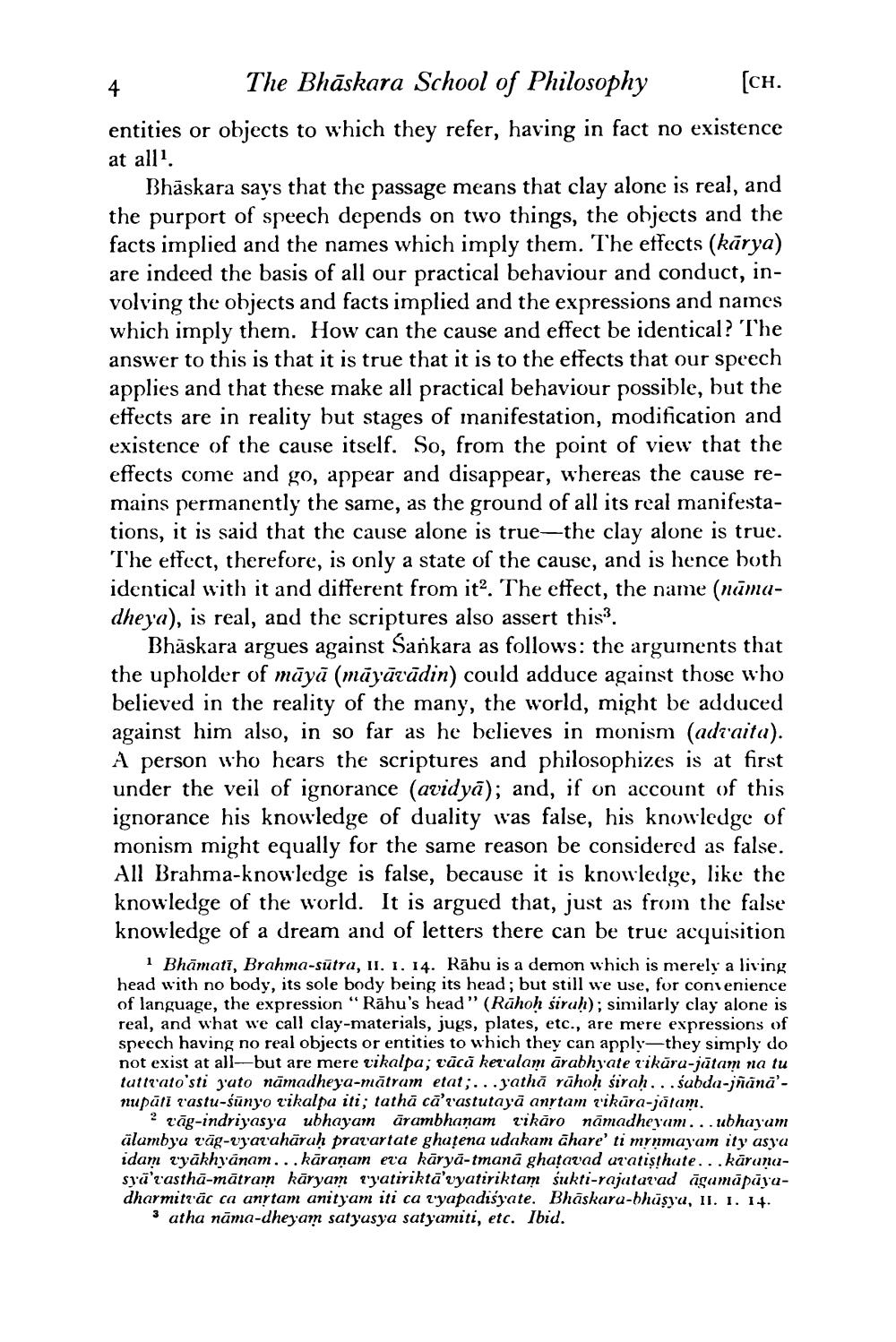________________
The Bhaskara School of Philosophy
[CH.
entities or objects to which they refer, having in fact no existence at all1.
4
Bhaskara says that the passage means that clay alone is real, and the purport of speech depends on two things, the objects and the facts implied and the names which imply them. The effects (kārya) are indeed the basis of all our practical behaviour and conduct, involving the objects and facts implied and the expressions and names which imply them. How can the cause and effect be identical? The answer to this is that it is true that it is to the effects that our speech applies and that these make all practical behaviour possible, but the effects are in reality but stages of manifestation, modification and existence of the cause itself. So, from the point of view that the effects come and go, appear and disappear, whereas the cause remains permanently the same, as the ground of all its real manifestations, it is said that the cause alone is true-the clay alone is true. The effect, therefore, is only a state of the cause, and is hence both identical with it and different from it2. The effect, the name (namadheya), is real, and the scriptures also assert this3.
Bhaskara argues against Sankara as follows: the arguments that the upholder of māyā (māyāvādin) could adduce against those who believed in the reality of the many, the world, might be adduced against him also, in so far as he believes in monism (advaita). A person who hears the scriptures and philosophizes is at first under the veil of ignorance (avidyā); and, if on account of this ignorance his knowledge of duality was false, his knowledge of monism might equally for the same reason be considered as false. All Brahma-knowledge is false, because it is knowledge, like the knowledge of the world. It is argued that, just as from the false knowledge of a dream and of letters there can be true acquisition
1 Bhāmatī, Brahma-sūtra, II. 1. 14. Rāhu is a demon which is merely a living head with no body, its sole body being its head; but still we use, for convenience of language, the expression "Rāhu's head" (Rāhoḥ siraḥ); similarly clay alone is real, and what we call clay-materials, jugs, plates, etc., are mere expressions of speech having no real objects or entities to which they can apply-they simply do not exist at all-but are mere vikalpa; vācā kevalam ārabhyate vikāra-jātam na tu tattvato'sti yato nămadheya-matram etat;...yathā rāhoḥ śiraḥ...śabda-jñānā’nupāti vastu-sunyo vikalpa iti; tatha ca'vastutayā anṛtam vikāra-jātam.
2
vag-indriyasya ubhayam arambhanam vikaro namadheyam...ubhayam alambya vag-vyavahāraḥ pravartate ghatena udakam āhare' ti mṛnmayam ity asya idam vyākhyānam...kāraṇam eva kāryā-tmanā ghaṭavad avatiṣşthate...karanasya'vasthā-matram kāryam vyatiriktā’vyatiriktam sukti-rajatavad agamāpāyadharmitvac ca anṛtam anityam iti ca vyapadisyate. Bhaskara-bhāṣya, II. 1. 14.
3 atha nama-dheyam satyasya satyamiti, etc. Ibid.




